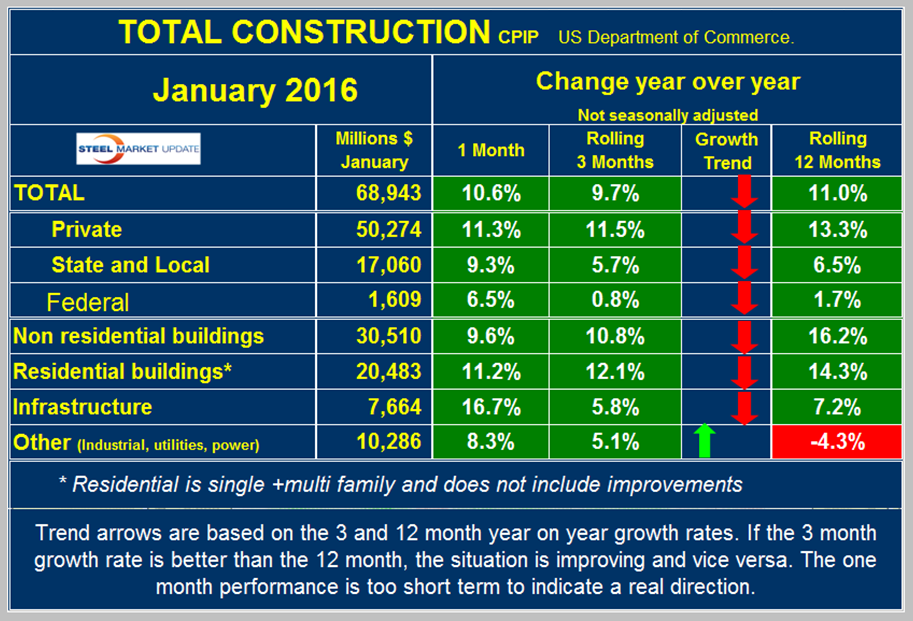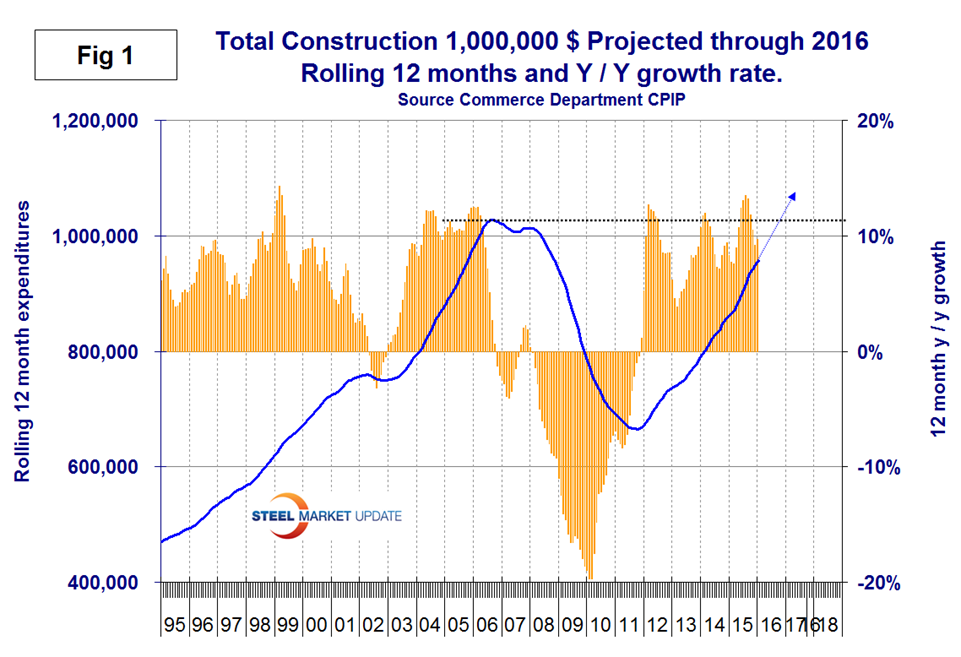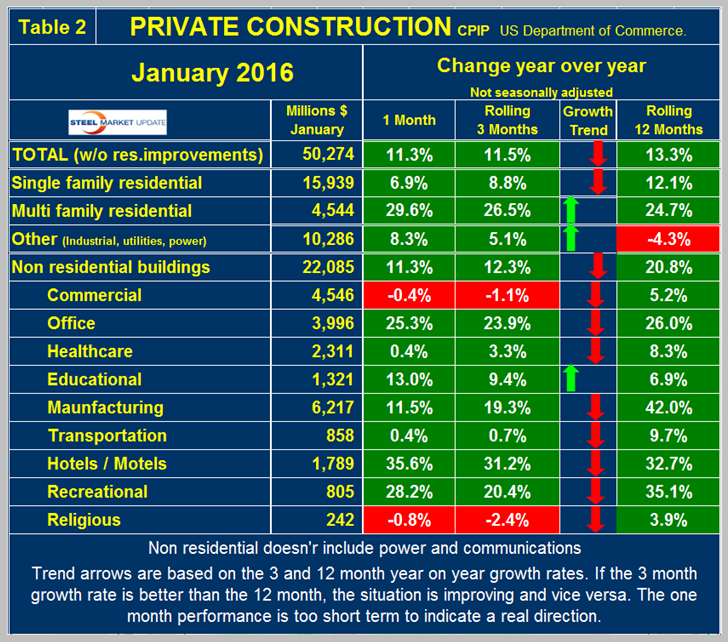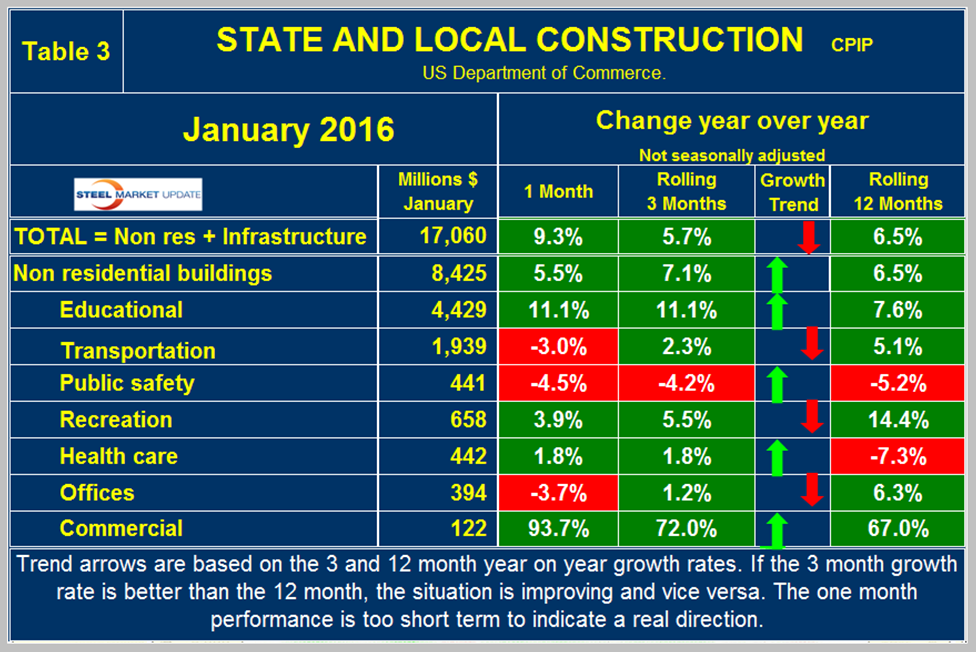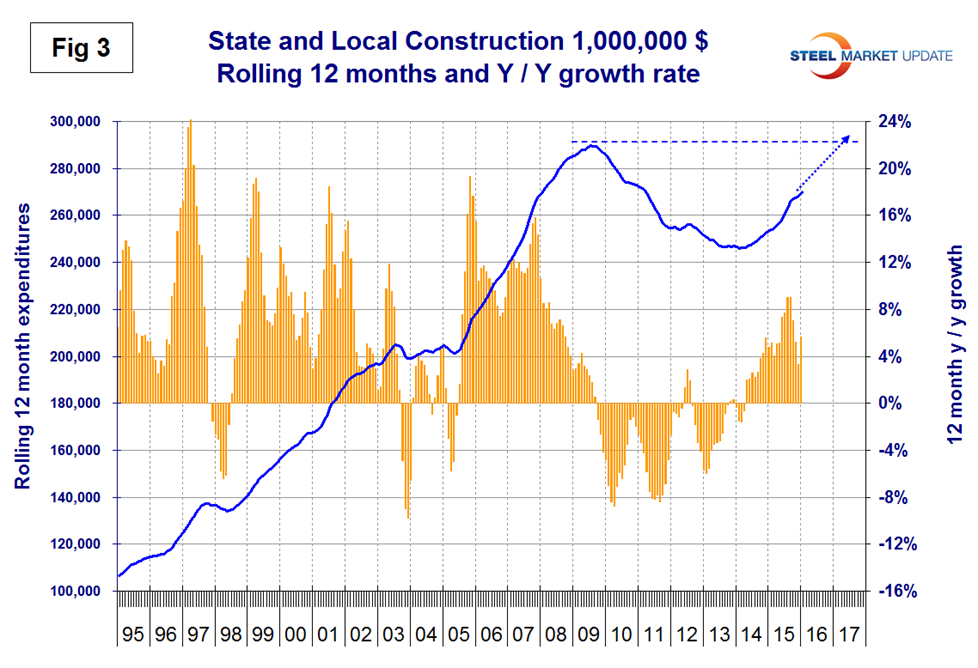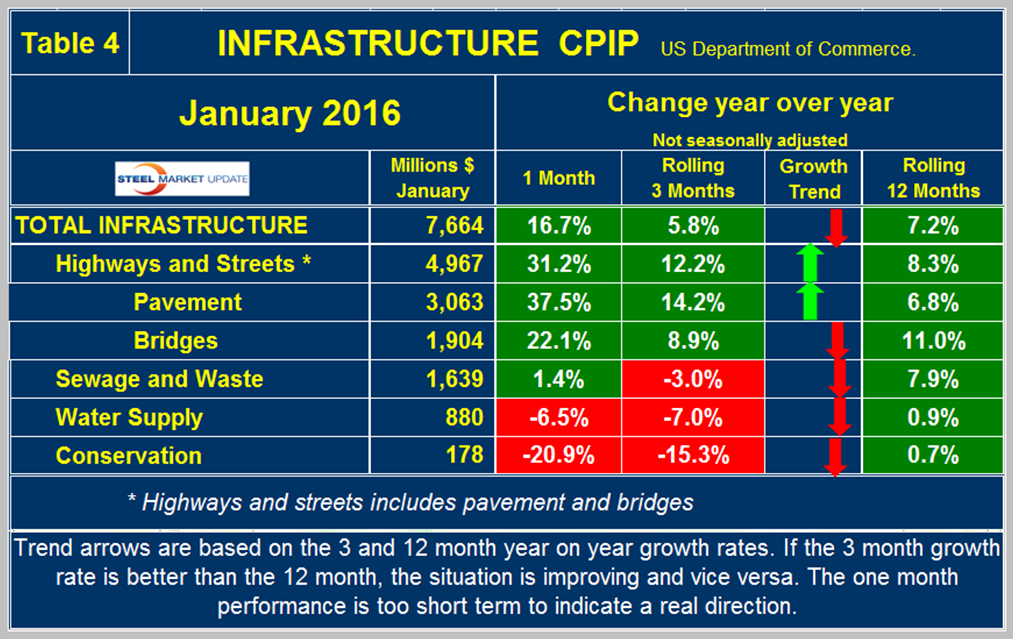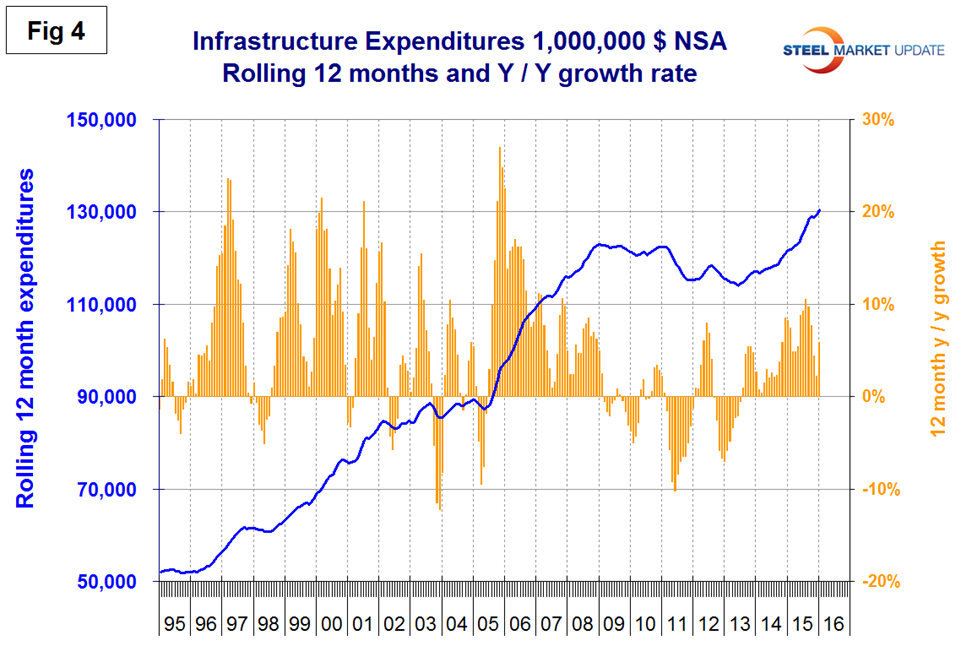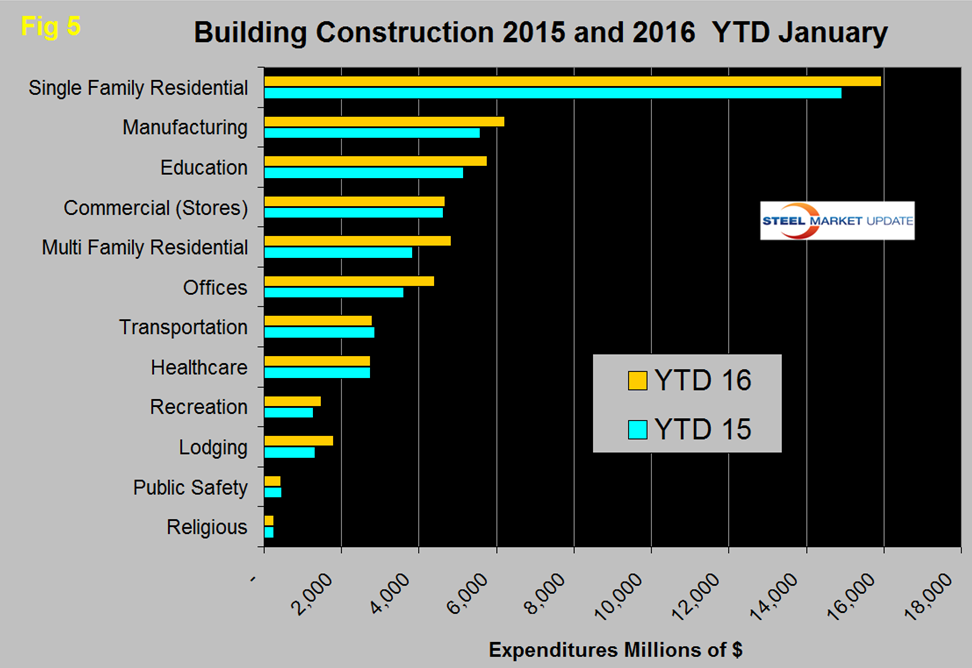Steel Markets

Construction Expenditures through January 2016
Written by Peter Wright
March 2, 2016
Each month the Commerce Department issues its Construction Put in Place (CPIP) data, usually on the first working day covering activity two months earlier. January data was released on Tuesday March 1st.
![]() Construction Put in Place is based on spending work as it occurs, estimated for a given month from a sample of projects. In effect the value of a project is spread out from the project’s start to its completion. This is different from the starts data published by the Commerce Department for residential construction, by Dodge Data & Analytics and Reed Construction for non-residential and Industrial Information Resources for industrial construction. In the case of starts data the whole project is entered to the data base when ground is broken. The result is that the starts data can be very spiky which is not the case with CPIP. In January there was a turnaround in the growth rate after four consecutive months of slowing since August last year.
Construction Put in Place is based on spending work as it occurs, estimated for a given month from a sample of projects. In effect the value of a project is spread out from the project’s start to its completion. This is different from the starts data published by the Commerce Department for residential construction, by Dodge Data & Analytics and Reed Construction for non-residential and Industrial Information Resources for industrial construction. In the case of starts data the whole project is entered to the data base when ground is broken. The result is that the starts data can be very spiky which is not the case with CPIP. In January there was a turnaround in the growth rate after four consecutive months of slowing since August last year.
At SMU we analyze the CPIP provided by the Department of Commerce with the intent of providing a clear description of activity in this steel consuming sector. Please see the end of this report for more detail on how we perform this analysis and structure the data.
Total Construction
We have reported previously that the June through December CPIP reports were excellent and on a year/year basis we find that January growth was good and picked up the pace. On a rolling three months basis year over year, June was up by 12.4 percent, July by 13.1 percent, August by 13.4 percent, September 13.1 percent, October by 12.0 percent, November by 10.9 percent, December by 8.0 percent and January by 9.7 percent.
January expenditures were $68.9 billion which breaks down to $50.3 B of private work, $17.0B of state and locally (S&L) funded work and $1.6 B of federally funded (Table 1).
The red and green arrows in Table 1 show momentum. Even though January on a 3MMA basis had an increase in year over year growth to 9.7 percent this was still less than the rolling 12 month growth rate of 11.0 percent therefore we classify this as negative momentum. Total construction will reach the pre-recession level before the end of this year if the present growth rate is maintained (Figure 1).
The 9.7 percent growth of total construction y/y was led by private work up by 11.5 percent. Note there is no seasonality in our analysis because we only report year over year results. Momentum was negative for all financing sectors, Private, S&L and Federal and for all building sectors and for infrastructure. Only “Other” construction which is Industrial, Utilities and Power had positive momentum. We consider four sectors within total construction. These are non-residential, residential, infrastructure and other. The growth rate of non-residential buildings and residential buildings is good but infrastructure and other achieved only little better than a 5 percent growth year over year. The growth rate of “Other” became very negative at the time of the oil price collapse but has recovered to positive growth in the last five months on a 3MMA basis. The growth rate of total construction is shown by the brown bars in Figure 1. The pre-recession peak of total construction on a rolling 12 month basis was $1,145 B in 12 months through February 2007. The low point was $665.1 B in 12 months through October 2011. The 12 month total through the latest data of January 2016 was $957.8 B. July through January were the first months to exceed $900 B since April 2009 when the recession was gaining traction.
Private Construction
Table 2 shows the breakdown of private expenditures into residential and non-residential and subsectors of both.
The growth rate of private construction was 11.5 percent in the last three months as shown by the brown bars in Figure 2.
The blue lines in all four graphs in this report are 12 month totals which smooths out seasonal variation. Excluding property improvements our report shows that both single and multi-family residential continue to have strong y/y growth but single family has negative momentum. The single family expenditures reported here have a rate of growth of 8.8 percent which is very similar to the 8.5 percent reported in the Census Bureau housing starts data. The growth of starts being about the same as the current expenditures we are discussing here suggests stability in the next couple of quarters. The growth of multifamily expenditures in this CPIP report is very much higher than construction starts of this sector reported by the Census Bureau. In this CPIP report multifamily expenditures are growing at 26.5 percent as the multifamily housing starts data from the Census Bureau is growing at 6.8 percent. This suggests a slowdown in multifamily for the next couple of quarters however multifamily permits are growing at >20 percent therefore any slowdown is likely to be limited. Private non-residential building expenditures grew at a solid 12.3 percent in three months through January y/y with negative momentum. Within private non-residential, all sectors except commercial and religious had positive growth led by hotels/motels and offices however all but educational buildings had negative momentum.
State and Local Construction
S&L work expanded by 5.7 percent in the rolling three months through January y/y with negative momentum (Table 3).
June through December had the highest growth rates for S&L construction since before the recession but growth slowed in each month of the 4th quarter then recovered to 5.7 percent in January. Figure 3 shows year over year growth as the brown bars.
Educational buildings are by far the largest sub sector of S&L non-residential at $4.429 billion in January and on a 3MMA basis y/y grew at 11.1 percent with positive momentum. Recreational buildings which includes convention centers, sports arenas, theatres and miscellaneous amusements grew at 5.5 percent in the latest data with negative momentum. Public safety, which includes jails, police, courthouses and fire stations is in a slump and has contracted for 37 of the last 38 months. Table 2 shows that S&L commercial buildings grew at 72 percent but this is a very small volume. Comparing Figures two and three it can be seen that S&L construction did not have as severe a decline as private work during the recession and that private work bounced back faster. Both the private and S&L expenditures have now recovered to the point that they should exceed the pre-recession peak by the middle of 2017.
Drilling down into the private and S&L sectors as presented in Tables 2 and 3 shows which project types should be targeted for steel sales and which should be avoided. There are also regional differences to be considered for which data is not available from the Commerce Department. In January 2015 the Bureau of Labor Statistics initiated the reporting of GDP data by state and by sector, including construction and when the next update is released in March we will initiate a routine analysis for our subscribers.
Infrastructure
Expenditures have had positive growth every month since July 2013 but growth slowed each month from August through December. In January there was a recovery to 5.8 percent year/year. Highway and streets including pavement and bridges accounts for about 2/3 of total infrastructure expenditures and had positive growth every month since April 2015 culminating in a 12.2 percent rate in three months through January. Highway pavement is the main subcomponent of highways and streets and had a 14.2 percent positive growth in three months through January. Bridge work has had positive growth for each of the last 14 months. Bridge work totaled $1.9 billion in the single month of January with an 8.9 percent growth rate (Table 4).
Infrastructure expenditures were slow to respond to the recession due to the magnitude of many of these projects. Growth stopped in 2009 and 2010 but it wasn’t until 2011 that an actual contraction occurred. For most of 2015 through January 2016 infrastructure expenditures exceeded the pre-recession high (Figure 4).
Total Building Construction Including Residential
Figure 5 compares YTD expenditures for building construction for 2015 and 2016.
Single family residential is dominant and in January 2016 totaled over $16.9 billion. On this year over year basis the only sectors to be trailing 2015 are public safety and transportation which are down by 4.5 percent and 2.0 percent respectively, at the other extreme lodging (hotels and motels) is up by 35.6 percent.
Explanation: The official CPIP press report gives no appreciation of trends on a historical basis and merely compares the current month with the previous one on a seasonally adjusted basis. The data is provided as both seasonally adjusted and non-adjusted. The detail is hidden in the published tables which we at SMU track and dissect to provide a long term perspective. Our intent is to provide a rout map for those subscribers who are dependent on this industry to “Follow the money.” This is a very broad and complex subject therefore to make this monthly write up more comprehensible we are keeping the information format as consistent as possible. In our opinion the absolute value of the dollar expenditures presented are of little interest. What we are after is the magnitude of growth or contraction of the various sectors. Data is reported by the Commerce Department on both a seasonally adjusted and non-adjusted basis. Their official commentary is based on adjusted numbers. In the SMU analysis we consider only the non-seasonally adjusted data because we don’t trust seasonal adjustments and in any case our businesses operate in a seasonal world. We eliminate seasonal effects by comparing rolling three month expenditures year over year. CPIP data also includes the category of residential improvements which we have removed from our analysis in the rational that such expenditures are minor consumers of steel.
In the four tables above we present the non-seasonally adjusted expenditures for the most recent month of data. Growth rates presented are all year over year and are the rate for the single months result, the rolling 3 months and the rolling 12 months. We ignore the single month year/year result in our write ups because these numbers can contain too much noise. The arrows indicate momentum. If the rolling 3 month growth rate is stronger than the rolling 12 months we define this as positive momentum and vice versa. In the text, when we refer to growth rate we are describing the rolling 3 months year over year rate. In Figures 1 through 4, the blue lines represent the rolling 12 month expenditures and the brown bars represent the rolling 3 month year over year growth rates.

Peter Wright
Read more from Peter WrightLatest in Steel Markets
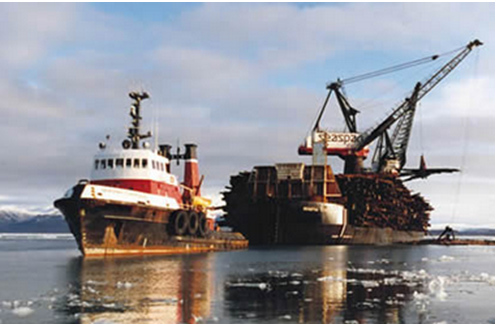
Glenfarne Alaska LNG and POSCO ink preliminary partnership
Glenfarne Alaska LNG and POSCO signed a preliminary strategic agreement during the GasTech Conference in Milan on Thursday.

Steel export volumes remain weak through July
Following a 3% decline in June, the amount of steel shipped outside of the US edged up 1% in July to 623,000 short tons. July was the sixth-lowest monthly export rate since the COVID-19 pandemic, and...
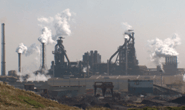
Hot-rolled market participants say ‘doldrums’ to roll on through year-end
Participants in the hot-rolled steel sheet market expect the market to remain subdued through the end of the year.

Market says cutting interest rates will spur stalled domestic plate demand
Market sources say demand for domestic plate refuses to budge despite stagnating prices.

Great Lakes iron ore shipments declined in August
Shipments of iron ore across the Great Lakes dropped to 5 million short tons (st) in August, according to the latest data from the Lake Carriers’ Association. That’s down 9.1% compared to August 2024 and 2% lower than the month’s 5-year average. All told, the year-to-date (YTD) iron ore volumes through August totaled 26.7 million […]

